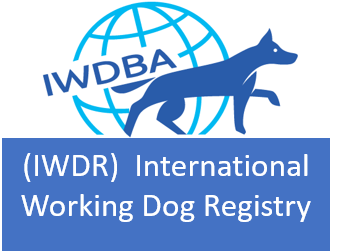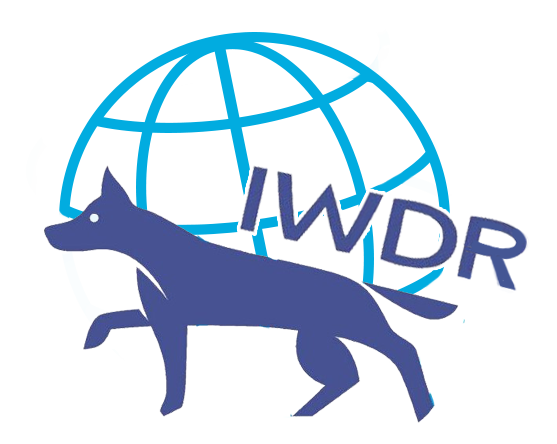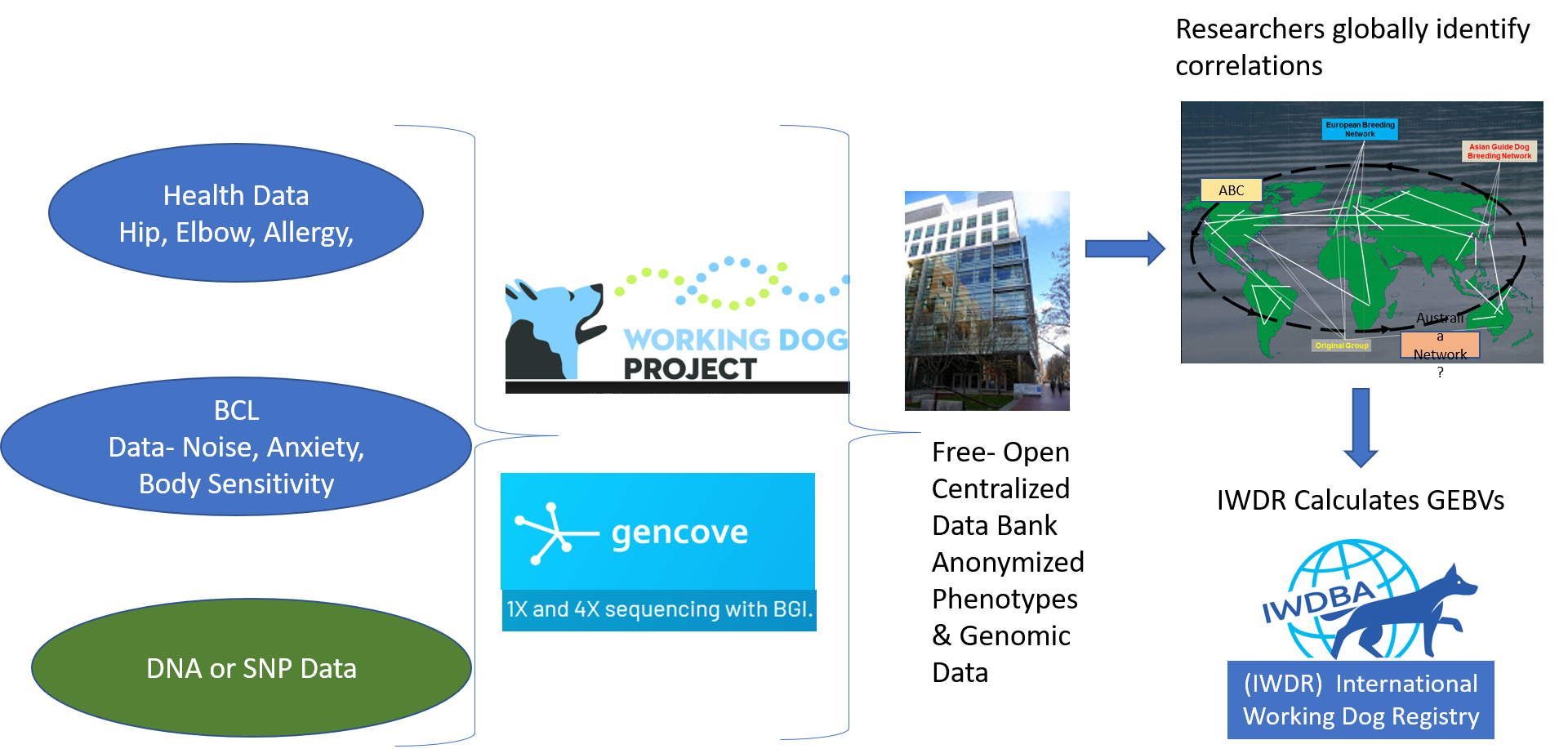

A Genomics Pilot Study: An Opportunity for IWDR Users to
Participate in the Working Dog Project
All IWDR users are invited to participate in a project to develop Genomically-Enhanced Breeding
Values (GEBV) for working dogs. This project is a collaboration between IWDR and scientists working
at the Broad Institute of MIT and Harvard. Organizations take part by collecting a DNA sample from
dogs that meet the enrollment criteria and sharing certain health and behavior data stored in IWDR.
For dogs in IWDR that are also part of ABC, participating in the Working Dog Project supports ABC’s
2019 and 2020 goals of standardizing all ABC dogs using the BCL. Each ABC member will also benefit
by gaining access to GEBVs, which helps your organization achieve your program objectives as well as
advance the goals of your membership in ABC.
This project is part of the Working Dog Project, which is building a shared, open access resource that
will support the development of new genetic tools for working dog programs. All data provided by
organizations is anonymized.
Funding is currently available to genotype at least 200 IWDR-enrolled dogs for this pilot study. To be
eligible to participate, dogs must have a record in IWDR that includes: (1) a PennHIP score provided by
either Antech or the University of Pennsylvania, and (2) at least one BCL record obtained at 4 months
of age or older. Cost of the DNA sample collection kit, shipping, and DNA sequencing will be covered
by the study. Your staff will, however, be devoting time to complete BCL scoring, collect a saliva swab
for DNA extraction, and mailing kits to the genetic laboratory.
- Make your CEO aware of this study and obtain their permission for dogs owned by your organization to be enrolled.
- Download this page as a PDF
- Print this PDF, after downloading it.
- Have your CEO or COO sign this paper form, then scan it back into a PDF, so it can be uploaded in step b.
- Enroll your organization in the Working Dog Project – Click Here to enroll
- Enrollment gives approval for behavior checklist, health diagnosis and pedigree data to be exported to The Working Dog Project’s centralized database. Dog names, identifiers, and organization owner and breeder will all be anonymized by the WDP prior to export into the publicly accessible database.
- During enrollment, IWDR will be queried to determine the number of qualified dogs owned by your organization. Organizations will qualify to complete enrollment if they own 5 or more qualifying dogs.
- Identify eligible dogs to enroll in the study. Eligibility requirements include ensuring each dog
has the following data in IWDR:- Dog has basic identifying data, such as breed, gender, and birthdate entered in IWDR
- Dog has at least one Behavior Checklist which you feel confident is accurately scored, and was obtained at 4 months of age or older.
- PennHIP score – by entering the PennHIP accession number you are certifying that Antech, or UPenn provided the score.
- Collect a saliva sample on Pilot Study enrolled dogs, and submit samples to genetic testing laboratory.
- Instructions on how to properly collect a saliva sample or cheek swab will be included with the initial supply of sample collection kits sent upon enrollment. It is a simple procedure.
- Enter each dog’s sample container barcode ID into IWDR using the scanner provided with your first shipment of sample collection kits. Instructions for using the scanner to enter the barcode number into a dog’s record in IWDR will be included.
- Collect DNA on additional dogs
- Organizations wishing to participate in WDP for the long-term have agreed to allow health and behavior data stored on their dogs in IWDR to be shared with the project. Dogs on which a saliva or cheek swab sample ID number has been recorded in IWDR will be considered as enrolled in WDP beyond the Pilot Study phase. Organizations may continue collecting DNA samples on additional dogs until WDP terminates.
- As funding becomes available, samples collected on dogs beyond the Pilot Study phase will be genotyped.
- Organizations may have additional reasons for obtaining whole genome scans on dogs they own. The organization can choose to provide funding to genotype their dogs, especially for a future collaborative project targeted for a specific health problem. The cost of genotyping is expected to be in the range of $110-$150 per dog.
Short Term Goal 1: The pilot will be a proof of concept for :
- Working out logistical details for moving both data and saliva samples from Pilot Study
enrolled organizations to the scientists who can begin utilizing these materials, - Fine-tuning the pipeline and system procedures for anonymizing data as it flows into a
centralized repository where researchers from around the world may begin using it to look
more closely for relationships between genetic markers and aspects of behavior documented
by the BCL, - Calculating GEBVs using phenotypes on the approximately 1,000 dogs in IWDR that have a
PennHIP score and genomic markers obtained from the first 200 dogs processed in the Pilot
Study. Completing this critical first step will allow development of the pipeline process that
needs to be followed to automate the GEBV calculating process.
Short Term Goal 2: A benefit to organizations will be discovering the genomic relatedness between
dogs. Inbreeding coefficients (COI) calculated using only pedigree relationships are based on average
relationships among individuals while COIs calculated using genomic data are based on actual genetic
similarities and differences among the markers possessed by the two dogs being compared. Genomic
relatedness is more accurate than traditional inbreeding coefficients calculated based on pedigree
relationships. These more precise relationships also factor in to increasing the accuracy of breeding
values estimated as GEBVs over EBVs estimated by more traditional techniques.
Long Term Goal: Because aspects of behavior are thought to reflect a quite complex interplay
between genetics and environment, we expect studies to unravel the age-old question of “nature vs.
nurture” to require years to complete and to require behavioral assessments and genomic information
on thousands of dogs of various breeds and pedigrees. If successful, this approach, over time, can be
used to gain a better understanding of genetic relationships among aspects of behavior and could
uncover genetic anomalies related to canine health problems. Having GEBVs can add scientific
precision to breeding decisions, and it can accelerate the rate at which genetic improvement
accumulates across generations because it will increase the accuracy of breeding decisions made on
young dogs.

